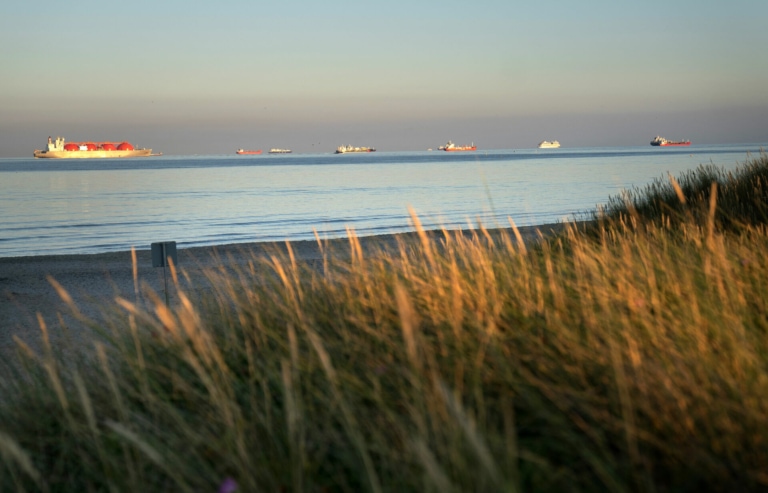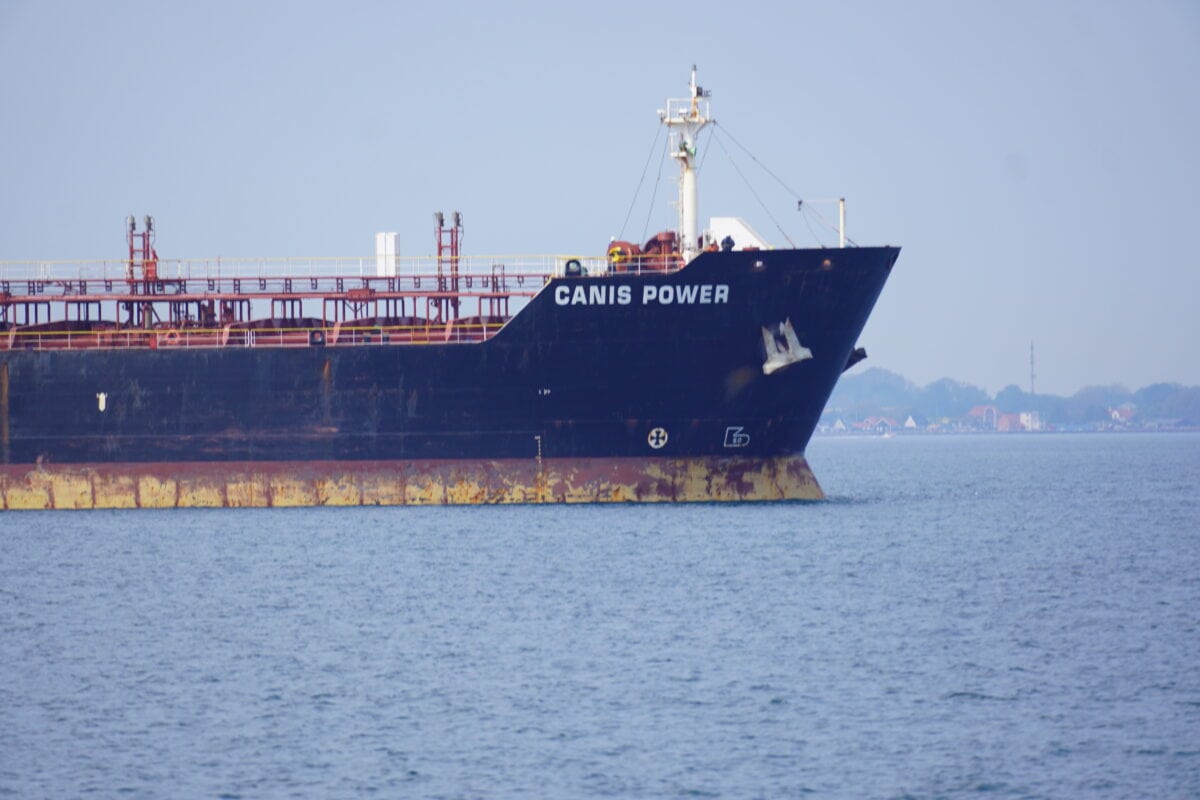
Since October, at least ten large oil tankers from Russia’s so-called dark fleet have been allowed to anchor in Danish waters off the port of Skagen.
According to international maritime data company Lloyd’s List Intelligence, they are part of a network that helps Russia make billions from the oil trade, bypassing EU sanctions.
Danwatch can reveal this based on data from MarineTraffic and Lloyd’s List Intelligence.
It may be both illegal and a circumvention of the sanctions against Russia that the vessels have docked in Denmark. And the ten vessels are just a random sample. Data from MarineTraffic and Lloyd’s List Intelligence shows that vessels from the dark fleet have docked at Skagen almost weekly since the sanctions came into force around the turn of the year.
Lloyd’s List Intelligence has analysed the ten vessels in Skagen and assesses that they are sailing without insurance, with hidden owners and with oil that has been traded far more expensive than what EU sanctions allow.
According to the World Bank, it is precisely these dark vessels that undermine the EU’s sanctions against Russia and have led to the current price of Russian crude oil averaging USD 80 per barrel, rather than the USD 60 price cap targeted by the sanctions.
The consequence of this is that Russia is making far more money for the treasury and thus the war in Ukraine, which was the reason the sanctions were imposed in the first place.
An example of this is the vessel Vela Rain, which sailed from the Russian oil port of Primorsk in the Baltic Sea on 16 October and arrived in Skagen on October. According to MarineTraffic, the huge oil vessel was loaded with up to 800,000 barrels of Russian oil, which has a value of almost half a billion Danish kroner.
Danwatch has attempted to contact the owner of Vela Rain, but they have not returned our request.
Michelle Bockmann, Chief Analyst at Lloyd’s List Intelligence, says that Denmark has a unique opportunity to control and detain oil vessels coming from Russia because they dock in Ålbæk Bay. The vessels do not dock in other European countries, she states.
“In ten minutes, I can make a list of oil vessels with no known insurance. So can the Danish authorities,” she says.
Many of the oil vessels sail with some form of insurance papers, but they are often “worth less than the paper they are written on”, says Michelle Bockmann.
“Many of the vessels fly the flags of countries like Gabon and Cook Islands. My cat could get insurance papers from those countries if it just presented some kind of insurance company to the maritime authorities in those countries. They don’t check anything,” she says.
Often, the insurance companies don’t even exist. And even though it is illegal, the vessels are still allowed to enter Denmark.
But in the future, Denmark may end up having to inspect these vessels – and on a much larger scale.
The Financial Times reports, based on anonymous sources in the EU, that Denmark has been selected to monitor oil vessels arriving from Russia. This is despite the fact that Denmark has so far not inspected the vessels at all, even though they have repeatedly been in Danish territorial waters.
When the oil tanker Canis Power suffered engine failure off the coast of Langeland in May, it quickly became clear that the vessel was part of Russia’s so-called dark fleet.
When the Danish Maritime Authority became aware of the Canis Power incident, they issued a request to have it inspected at the first opportunity by the countries in the Paris MoU, which is an international agreement on port controls in Europe, among other places.
But there is no difference between Canis Power and the other ten vessels that have docked at Skagen, says Michelle Bockmann.
“If they believe that Canis Power is suspicious due to safety risks, they should make the same assumption for the other ten vessels,” she says.
When the dark vessels dock in Ålbæk Bay, they are not inspected by Danish authorities. It is not customary to do this at anchorages unless there is a concrete suspicion against a vessel.

However, in the ten cases where Lloyd’s List Intelligence assesses that the vessels at Skagen have sailed without insurance and with sanctioned cargo, Denmark should have inspected them anyway. This is according to Philip Max Cossen, associate professor of Maritime Law at Svendborg International Maritime Academy.
“It’s within the realm of port state control. It’s clear grounds. There is a strong suspicion that these vessels do not comply with their obligations and do not have the documentation in place,” he says.
The oil vessels sail from the western Russian oil ports – mainly Primorsk – to Ålbæk Bay near Skagen, before continuing on to countries such as India with the oil.
Philip Max Cossen points out that, by law, the Danish authorities should react to the vessels if they do not have the convention-bound and internationally recognised CLC insurance.
“It’s a clear ground for detention if they don’t have a CLC certificate,” he says.
And if the oil cargo is found to be sanctioned, the oil must be confiscated, he says.
Danwatch is working to get a comment from the Danish Maritime Authority. This was not possible before publication.
According to Lloyd’s List Intelligence, many of the shady oil vessels sail for shipping companies with only that one vessel affiliated, and if you take a closer look at the owners of the vessels, the address is often somewhere in India or the Middle East, where there is no shipping company present at all, says Michelle Bockmann.
“They only exist on paper. Often they don’t even have an email address associated with their company. Therefore, it’s hard to hold them accountable if an accident happens,” she says.
There have already been several accidents with dark vessels. Most recently, it was the vessel Pablo, a large oil tanker that exploded off the coast of Malaysia in May.
There was no cargo on board and therefore no oil spillage, but several crew members died during the accident on the old vessel.
It later turned out that the vessel’s insurance company didn’t exist either, which is why Pablo still remains in the same place where the explosion took place.
“The Pablo was sailing under the flag of Gabon, like many of the vessels in Denmark. No company will clean up after the accident because there is no one to pay for the cleanup,” says Michelle Bockmann.
However, it’s easy to get to the bottom of whether insurance companies even exist, says Michelle Bockmann.
When he vessels present their insurance documents – the so-called blue cards – in some cases it can be as simple as Googling the name of the insurance company to reveal that they don’t exist, she says.
According to the Financial Times, it has not yet been confirmed that Denmark will inspect all oil vessels arriving from Russia. However, Kremlin spokesman Dmitry Peskov has stated that it would be against international law if the vessels were stopped in international waters on their way through Denmark.
He was also asked whether Russia will use warships to escort oil exports through Denmark. Dmitri Peskov did not want to comment on this.